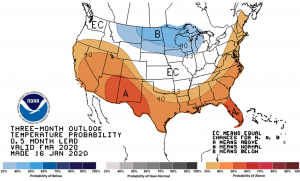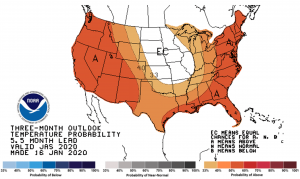January Market Conditions: Weather Rules the Markets! Record Warmth Brings Record Low Prices
What to Know, Now
Supply and demand in the wholesale natural gas market impact electric and natural gas prices across the country. The U.S. stores natural gas to ensure we have an adequate supply for the winter; thus, the amount of available stored gas affects the market. Natural gas is also the primary fuel for electric generation, so its price directly impacts electric rates. Currently, the recent mild winter temperatures have bolstered storage levels that are now 19% above last year’s volumes. This storage surplus (in the chart below) is resulting in natural gas prices reaching record lows. Here are a few key points worth noting at this time:
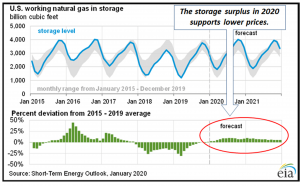
The Bottom Line: Very low prices are creating excellent buying opportunities for customers needing fixed pricing to control costs. Customers who are on index pricing are also seeing lower rates at this time, with the exception of colder periods when demand causes price spikes. Over the next six months, upward price pressure is expected from near term cold temperatures, increases in liquified natural gas (LNG) exports, and from increased economically-driven well shutoffs. Overall trends favor adequate stored supply and lower prices.
The natural gas spot (cash) prices are forecasted by EIA (federal government) to average $2.33/MMBTU in 2020, while the current monthly NYMEX futures rates for 2020 average $2.78/MMBTU. This difference indicates that rates are expected to get lower as they expire later in 2020. As an example of the recent price drop from the mild weather, the February futures contract dropped from $2.90 in November to its current level below $2.00.
After the winter, natural gas prices are expected to remain soft and well below $3.00/MMBTU.
February 2020 NYMEX Natural Gas Futures – Price History
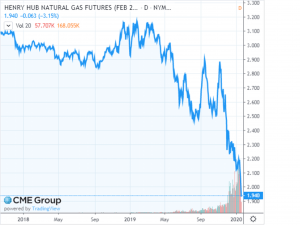
What to Know About 2020
Natural gas production is estimated to outpace consumption and is expected to bring back a moderate surplus. Prices for natural gas should be low, with local pipeline constraints representing the greatest price risk. The low natural gas prices aid electricity rates, but we are likely to see increases in future rates as generation sources (coal, natural gas, solar, wind) continue to change.
What To Do Now
Prices are currently low for natural gas and only slightly reduced for electricity. If you have accounts on utility supply or a variable rate, this is a good time to consider moving to a fixed rate.
Market Prices
NATURAL GAS
Wholesale Market: Current 2020 NYMEX prices are 17% lower than 2019’s average prices, and 2021 prices are 10% above current 2020 rates. Declining prices in the NYMEX Futures market create lower fixed-price contract rates and are an indicator that the market expects future prices to remain low. Basis transportation costs remain high and will make heating accounts much more expensive than level usage non-heating accounts.
ELECTRICITY
Wholesale NY Market: Prices have been in a favorable buying range supported by the softer natural gas market in 2019 and into 2020. The future years have higher prices because of increases in capacity costs and high electric rates anticipated with the shutdown of the Indian Point nuclear plant and the recently approved environmental law, Local Law 97 Carbon Emissions Cap.
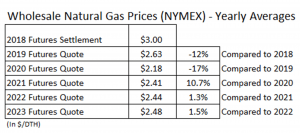
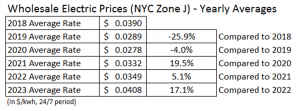
Temperature Probability Maps
Current temperature forecasts for the remainder of 2019 are calling for above-normal temperatures across most of the United States. The weather pattern is a moderate El Niño which is expected to bring a mild fall across the country and below normal temperatures for the middle of the U.S. later in the winter. The east coast will have mostly mild weather with more normal temperatures expected later in winter. If the fall and winter forecasts hold, we could see continued low prices into the winter and through 2020.
Feb./March/April 2020 Summer 2020
